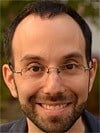At the end of each day, a dead body remains. Beneath all the layers of busy activity and earnest striving—a dead body. We lie down again, and when we arise, there it is still. In our clothing, in the walls of our buildings, in our food—a dead body.
No matter how we might try to ignore it or explain it, people die as a result of global inequality, which is perpetuated for the sake of our easy access to the cheap resources and labor that support our affluent ways of life.
We do the best we can. We teach tzedakah and preach that a righteous person must always strive to recognize God in the Other. We buy informative books and click on e-action alerts. Many of us even participate in, fund and found organizations that do inspiring work to alleviate the world’s injustice. Yet at the end of each day—a dead body remains.
In Parshat Shoftim, this stubborn, silent corpse makes its presence felt:
If a dead body is found… fallen in the field, and it is not known who killed it … The elders of the town nearest to the corpse shall then take a heifer [and] in the wadi they shall break the heifer’s neck. … Then [they] shall wash their hands over the heifer whose neck was broken in the wadi. And they shall make this declaration: “Our hands did not shed this blood, nor did our eyes see it done …” And they will be absolved of bloodguilt.[1]
There is a common reading of this ritual of the eglah arufah (“the broken-necked heifer”) that applauds it for holding us, as a community,[2] responsible for addressing a murder, even when we are not directly guilty. We marvel at the Torah’s insight and sensitivity, while envying our ancestors for having access to such a profound ritual.
Yet I find that reading inadequate for our times, and the ritual troubling. If we are truly held accountable for this murder, can we so easily be absolved? Can we really just wash our hands, mumble a few lines of prescribed liturgy and be done with it?
This discomfort and dissatisfaction is shared by the early Rabbis. The Mishnah, taking up the ritual of the eglah arufah centuries after the Torah’s completion, asserts that the practice was actually discontinued “from when the murderers increased.”[3] On the surface, the Mishnah is merely reporting the change, suggesting that the ritual became impractical once murder became commonplace—as though there weren’t enough heifers and wadis.
But I believe that the Rabbis, dissatisfied with the ritual’s theology of justice, actually want to undermine it and prevent its return.
We find this dynamic later in the very same mishnah. In parallel language, it reports on the abolition of another Torah ritual, hamayim hamarim, “the bitter waters”—an ordeal for testing women suspected of adultery. According to the text, this torment was discontinued “from when the adulterers increased,” apparently as a practical matter. Yet as Rabbi Judith Hauptman has demonstrated, the Mishnah’s overall treatment of this ritual amounts to a gradual “rabbinic revolt” stemming from “the desire… to eliminate a practice that confounded their notions of justice and morality.”[4] We can posit a similar dynamic with the eglah arufah: unable to disparage a Torah institution explicitly, the Mishnah laconically explains that current conditions are just not suitable.
Therefore, by the time of the Mishnah, no religious ritual could induce God to absolve the community of a murder. Every dead body had to enter the human machinery of police, courts and cemeteries. If justice was not brought about by humans’ own effort, then the bloodguilt remained with them.[5]
We still live in an era in which “the murderers increased”; yet the Mishnah, in reassessing the Torah’s ritual of the eglah arufah, insists that we cannot wash our hands of these deaths from war, poverty and other preventable causes—even those for which we are not directly guilty.
As we go about our lives, raising our families and doing the best we can to make a positive difference, we should not be too quick to congratulate ourselves for our modest contributions. We should stay aware of the real stakes and consequences. For somewhere, someone is coming across more bodies in other fields—and looking for “the elders of the town nearest…”
[1] Dvarim 21:1-8.
[2] The elders perform the ritual as leaders and agents of the entire town.
[3] Mishnah, Sotah 9:9.
[4] Hauptman, Judith. Rereading the Rabbis: A Woman’s Voice. Boulder: Westview Press, 1998, p. 15. The Mishnah limits the cases where the ritual of the bitter waters would apply and restricts its efficacy by impugning the morality of the woman’s husband and alleged lover.
[5] See the Babylonian Talmud, Sotah 47b, which states that the ritual was discontinued “because it was only brought for cases of doubt.” Rashi comments there: “but now we know who the killers are.” That is, in a culture where killing is commonplace, we have enough knowledge and awareness to assume full responsibility for all murders.

